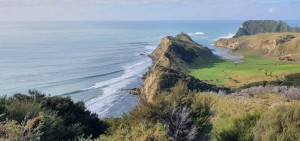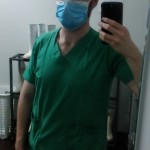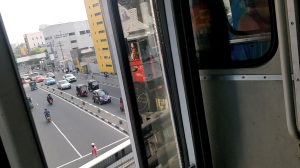My original plans, to spend a month in Colombo and then travel to Darwin, were dashed by COVID-19. After a few weeks in self isolation and a few more weeks going bonkers attempting to get a new placement signed off locally at the worst possible time for an elective medical student, I was offered a spot with Gisborne Hospital.

Gisborne might just be the most beautiful region in NZ
I hadn’t been to Tairāwhiti before, but I’ve always wanted the chance. For someone keen on rural practice, Gisborne definitely fits the bill, being nearly impossible to pass through by accident. It’s a jaw-droppingly beautiful region, with a fascinating (and sometimes terrible) history of tangata whēnua heritage and colonial contact with Captain Cook and the settlers. Unfortunately, it is also one of the places most impacted by healthcare inequity in New Zealand. As someone interested in working in this space in the future, I took this as an important learning opportunity and definitely found the experience to develop my understanding of the health inequity we have within our own borders. › Continue reading…

Surely this can't be the last time I see Sri Lanka? There's still so much left to do.
If you’re reading this now, you’ll know that things didn’t go as planned.
Friday passed by in a blur of morbidity meetings, motor vehicle accident patients, and fractures. After work, I got drinks with some of the local and foreign students, and we talked about how COVID-19 was becoming a bigger concern. One of the Australian students mentioned that someone had pointed at him in the street and yelled “Corona!,” which we put down to a bit of hysteria as we’d heard was happening back home too. › Continue reading…

Leaded up and discussing the ERCP. Nurses here all wear these classic-style uniforms.
I kicked off the day with an exciting opportunity – today was a scheduled list of endoscopic retrograde cholangiopancreatography (ERCP), a top Scrabble word well worth memorising. It’s also a highly specialisedway to examine diseases of the pancreas and bile duct using real-time x-rays, fluorescing contrast injections, and a long controllable tubal scope passed from the mouth through down to the stomach and duodenum. This hospital is renowned for its surgical work in these areas, so it was a good chance to see the masters at work. › Continue reading…

Finally, surgical scrubs that double as a St. Paddy's outfit.
Day 2: No snakebites, no mosquito bites, and no enforced shaving. I’m thriving!
I joined in the morning rounds with the surgeons, and just as I was warned, the questions started firing. The head surgeon didn’t see me at first, so I escaped the few rounds as my new German and Australian friends fielded. But now he was pointing intently at a nasty looking wound on a man’s leg and expecting an elective student answer, and I could tell I wasn’t going to be able to dodge these much longer. › Continue reading…

Demonstrating the IV line tourniquet. This is actually pretty genius and works fine.
I feel like I’m in an American medical drama walking around in my white coat. Standards of dress are very important here, though I was alreadyin formal ‘surgery-mode’ from the get-go. I’m striking out in one way, though: I’ve been told local students aren’t allowed facial hair. I’m constructing elaborate camouflage plans to hide my beard. Trundling through fields of deadly snakes is one thing, but dealing with weeks of patchy regrowth? Pass the snakes.
Down the path to the left, around the corner, service lift up, and you’re in Ward 25, the male surgical ward. I’ve started familiarising myself with my surrounds. It took me a bit of experimenting to figure out how their cannulas work for putting in lines, which look very different to what I’m used to. No tourniquets here for popping out veins when you take blood; a bit of IV tubing tied in a knot looks basic but still does the job perfectly. No pre-packaged alcohol swabs either – you make your own swab on a stick and dunk it in the alcohol jar. The drugs sit in beautiful multicoloured jars like a lolly shop, and I can’t help but rummage through them. › Continue reading…

Welcome to the Jungle, We Got Snakes and Pain
We were out of time to see more of Anuradhapura, but my friend had invited me to visit his village, and I’d jumped at the chance to see another side of Sri Lanka beyond the bustle of busy Colombo. Rajanganaya was a short trip away by car, and Kasun’s family welcomed me in. I got a motorbike tour of the township and his local clinic, and started working on my Sinhala. I’ve picked up a few bits and bobs: ස්තුතියි (stūtiyi, thank you), මොකක්ද? (mokakda?, what is it?), ඇයි hospital එකට ආවේ? (æyi hospital ekaṭa āvē?, Why [did you] come to [this] hospital?). I’m trying to pick up some basic Tamil phrases, too (வணக்கம்! Vaṇakkam! Hello!). There’s really not enough time to work on language skills to any functional level, so I’m just getting what I can as I go. Luckily, the doctors all speak English. › Continue reading…

The Jaya Sri Maha Bodhi. This as close as it gets.
I feel like months have already passed, but I’m still just finishing my first week here. Monday is Navam Poya, a public holiday, so I’ve got a brief opportunity to see some of Sri Lanka before I go back to CSTH’s surgical wards. Sri Lanka has no shortage of amazing historicalsites, and has had complex influences from India, China, the Netherlands, Portugal, Britain, and more. With only a brief window moment to explore, though, it was impossible to pass up Anuradhapura, home to some of the world’s most famous Buddhist sites. › Continue reading…

T. cruzi, the nasty behind Chagas. Over 6 million have it, but it's hardly talked about.
Throughout the week, I’ve continued working through all the parasites with the wonderful team of staff. They’ve really made me feel at home, offering me cups of (unbelievably good) Sri Lankan tea, welcoming all my questions, and giving up a lot of time to teach and help me. Dr Ranasinghe was incredibly supportive and happy to answer all my newbie parasitologist questions, and I’ve learned an enormous amount. I have a side interest in tropical and neglected medical illnesses from following Médecins sans frontières (Doctors without Borders) missions over the years, and a highlight for me has been squeezing in time to go through their international samples and see some of the exotic parasites I’d read about that. Two that caught my eye were the parasites behind African sleeping sickness and Chagas diseases, Trypanosoma brucei and Trypanosoma cruzi respectively. › Continue reading…

Don't move a muscle. They haven't seen me.
Day Two at the Anti-Filariasis/Anti-Malaria combined Units in Werahara, this time here for a presentation on malaria. Given that it’s a disease still killing 400,000 people worldwide each year, malaria is something we hardly think about in New Zealand. When was the last time I got worried about being bitten by a mosquito?
I knew a few basics going in, but there were a lot of details to sink my teeth into. Malaria is caused not by one but by five different species of Plasmodium parasites, which primarily attack the red blood cells. The life cycle, drug resistance and treatment protocol, and disease prognosis varies between each species. › Continue reading…

The bus doors never close. I decided against leaning out for a better look.
Next stop: the Anti-Filariasis and Anti-Malaria Unit! Time to start finding my way around. Something that fascinates me when I travel is seeing how local transport systems work. It might sound far removed from medicine, but commuting is something that almost every person does on a daily basis. It’s also necessary for patients accessing medical services, and may be limited by poverty, disability, or other factors. Is transport affordable for all, or do those without good jobs have to walk? Could I get to the hospital on crutches, or in a wheelchair? Do people wear seatbelts here? I love trying to break down a new environment and try to figure out how it interacts with the wellbeing of its people. I always insist that I want to work directly with patients, and I get chills when I realise there’s a public health passion in there somewhere beckoning me to the dark side of academia. Horrifying. › Continue reading…










